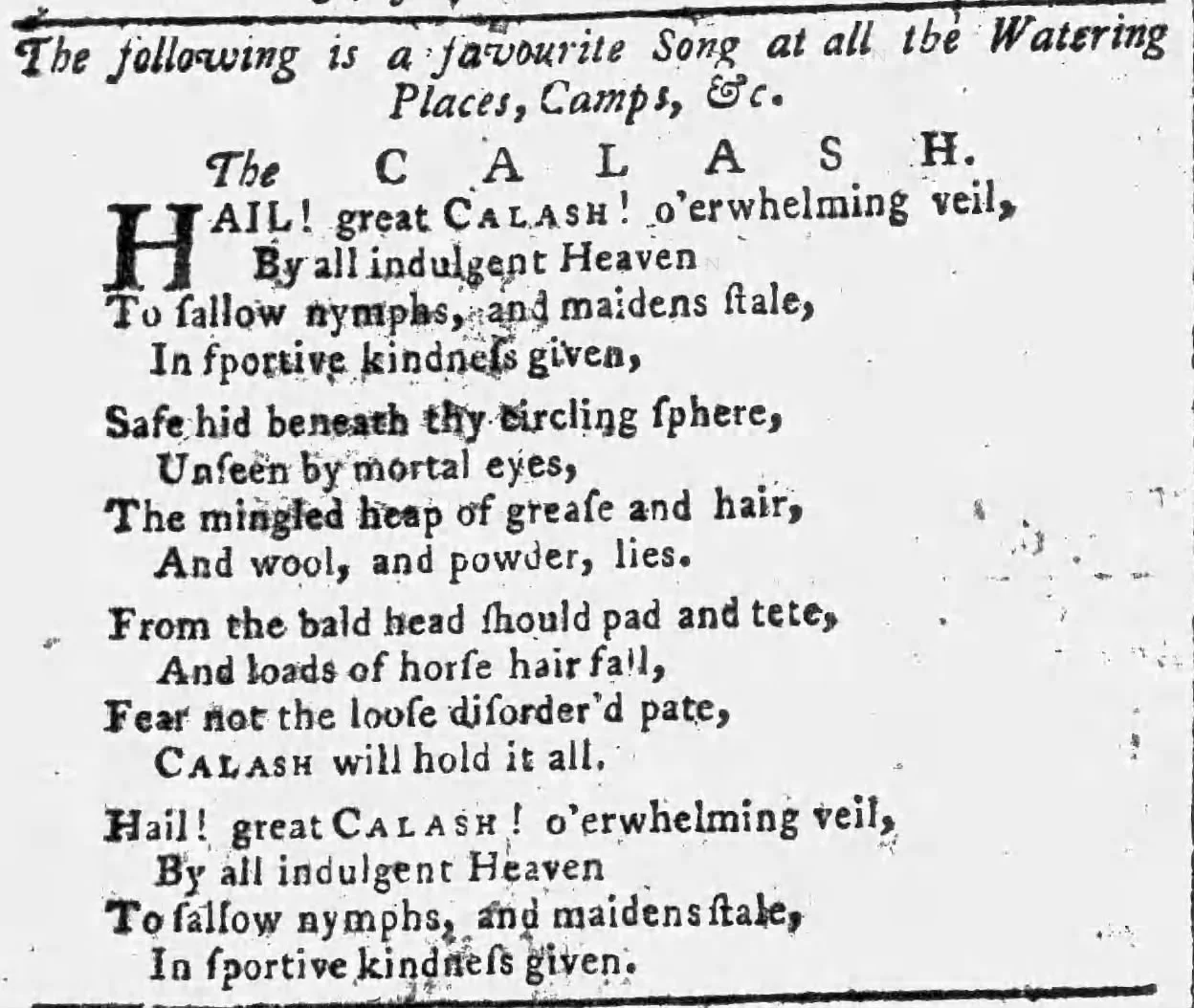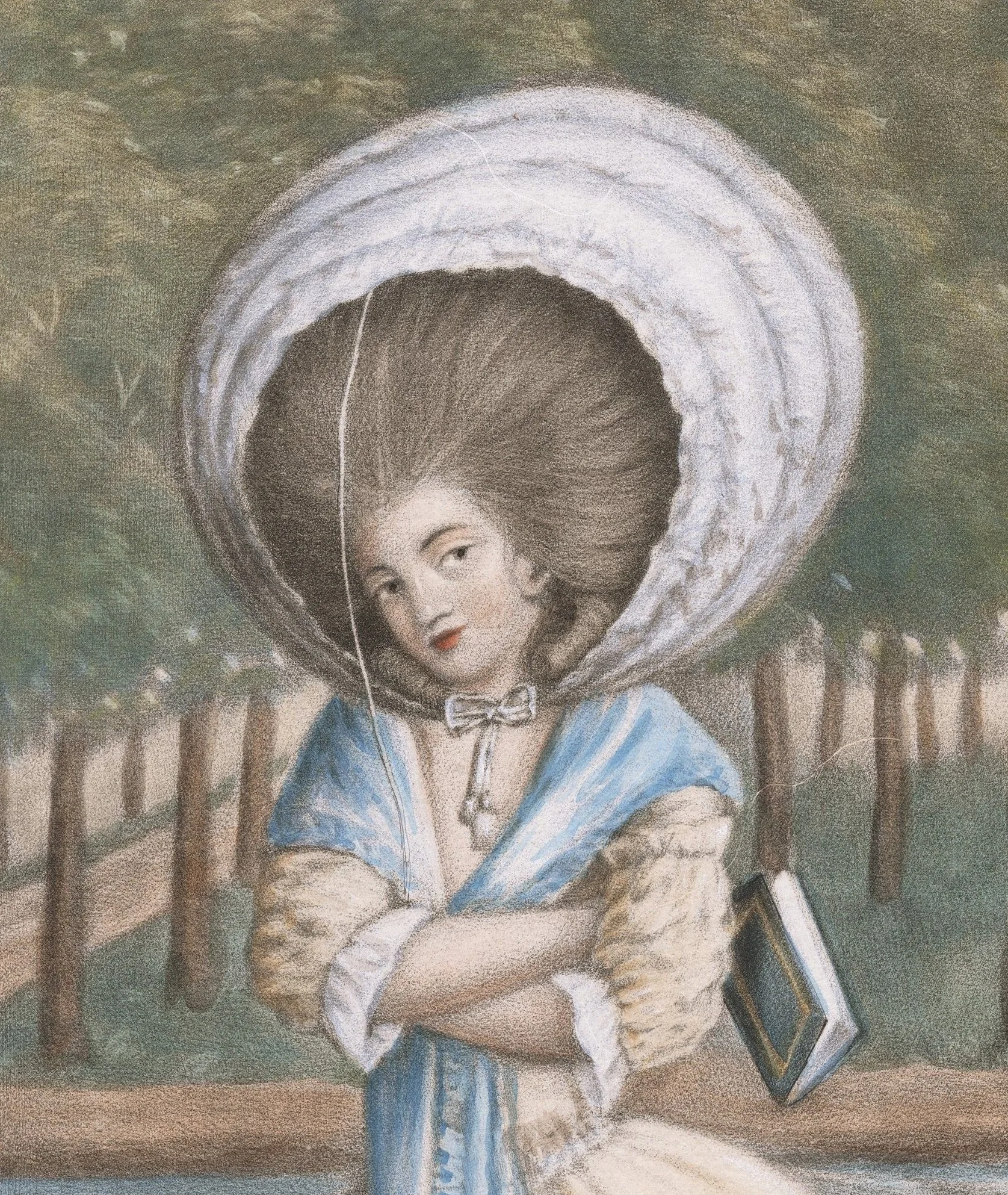18th Century Women’s Calashes
The Annals of Philadelphia suggests that what we call a “calash” was just one of several different styles of bonnets (as sketched by the author’s mother):
“The musk melon” bonnet, used before the Revolution, had numerous whalebone stiffeners in the crown, set at an inch apart in parallel lines and presenting ridges to the eye, between the bones. The next bonnet was the “whalebone bonnet,” having only the bones in the front as stiffeners. “A calash bonnet” was always formed of green silk; it was worn abroad, covering the head, but when in rooms it could fall back in folds like the springs of a calash or gig top; to keep it up over the head it was drawn up by a cord always held in the hand of the wearer.
From the Cambridge Chronicle and Journal, August 14, 1779:
Additional Resources
This site contains affiliate links for which I may be compensated
Constructing a late 18th century calash
Covering Your Hair with a Calash (if it's 1777)
Virgil’s Fine Goods: Calash patterns & kits
Extant calashes
Christie’s 5284, Lot 1903, an 18th century calash in deep green silk over cane hoops, with a gauze lining
Met C.I.45.68.44, America (?)
MFA 59.273; “Probably American, 18th Century Calash. Olive green lutestring on reed frame. Double ruffle around face. Narrow ribbon sewn across front opening. Short collar sewn along botton edge. Bow at back. Two long ribbons, lighter in tone, fall from front.”
MORR 4021, taffeta sewn with linen thread
Historic New England 1988.140, c. 1760-1800; “Tan (discolored) cotton; ruching w/ self-fabric piping and 2 cane hoops at brim; 14 cane hoops; center back panel insert; original neck ruffle has been replaced--but remains of piped edge of original are still visible; center back panel supported and stiffened by a piece of square cardboard.”
Historic New England 1988.141, c. 1760-1800; “Folding bonnet; replacement ribbons; lg bow in back green.”
A woman’s calash, c. 1765-1830, in Fitting & Proper; “brown silk twill partially lined with tan linen, stiffened with cane, trimmed with 2¼-inch picot-edged silk ribbon”
Christie’s Lot 63 / Sale 4332, “A calash of black silk, interlined and lined with pink quilted silk, edged with net - circa 1770”
Kerry Taylor Auctions, 7/10/2007, Lot 44, “An extremely large calash bonnet, 1770s, with fan-shaped pleating to back, internal curved cane struts, lined in ivory silk, 78cm 30½in long overall”
Amsterdam Museum KA 20131, in light brown silk, c. 1770-1780
Historic New England 1985.682, c. 1770-1785; “Pale blue silk lined with sheer coarse woven cotton; gathered on whalebone(?) hoops; long braid at center, top for pulling calash over head; trimmed with cream lace.”
V&A T.45-2015, “A woman’s calash of dark green silk, gathered over 4 whalebone ribs with dark green silk ribbon ties,” made in England c. 1770-1790
National Trust 1349830, c. 1770-1790; “Made from green-brown glazed cotton with 6 split cane hoops. There is a self fabric bow centre back with scalloped and pinked edges. it fastens with fawn silk ribbon draw ties joined in small bow at the centre back. There are self fabric ties at the front and a fawn silk ribbon loop from centre front edge for holding calash extended in use.”
National Trust 1349831, c. 1770-1790; “Made from dark brown glazed cotton and lined with pink glazed cotton. There are 6 cane hoops pleated into the centre back and gathered at the lower edge. There is a short unlined curtain. It is trimmed with black ribbed silk ribbon bow at centre back of crown. It fastens with black silk ribbon drawstring at the neck and there is a black ribbon loop joined to each side of the front edge for holding the calash extended.”
Monmouth County Historical Association 699, possibly made in New Jersey, c. 1770-1790; “Green silk, lined with openweave linen. Six reed hoops run through casing channels, sewn to an attached ruffle at the neck. The front edge of the calash is trimmed with a shallow piped ruffle. A large green silk ribbon bow is sewn to the center back panel. The calash includes a portion of what appears to be the original neck tie ribbons, and a later green silk ribbon retainer loop.”
National Trust 814603, c. 1770-1839
Rijksmuseum BK-NM-5585, brown cotton twill calash lined in pink silk, Netherlands, c. 1775-1783
Rijksmuseum BK-NM-10000, a Thérèse in black silk, c. 1775-1783
Met C.I.38.100.19, c. 1775-1785
Colonial Williamsburg 1960-722, England, 1775-1785; “black silk taffeta lined with pink silk and padded with soft cotton batting; ruffled at neck edge. Bonnet is fashioned with four flat cane or reed ribs in crown. Ribbons stitched to face edge are probably for the wearer to hold to keep the calash from collapsing backwards in the wind.”
Colonial Williamsburg 1960-723, England, 1775-1785; “dark green silk taffeta with rose silk lining. The bonnet has five reed or cane ribs in the crown and one inserted horizontally around the neck above the neck ruffle. Green silk ribbons tie at neck.”
MFA 99.664.77, America, last quarter of the 18th century; “Green silk calash or bonnet with cane ribs, horseshoe-shaped caul, double flounce with corded edges around face, bavolet or neck curtain with corded edges, bow at back, green ribbon ties at chin”
Colonial Williamsburg 1960-722, black silk calash, England, c. 1780
Met 1975.128.4, c. 1780
Manchester 1955.271, c. 1780-1800; “Green silk lined with cream glazed cotton. Gathered at front edge with drawstring tying at top, closely gathered at centre back and seamed below. Lower edge with frill below, and tying with ribbon strings under chin. Gathered to 3 whalebone hoops.”
Philadelphia Art Museum 1913-251, a calash made of printed and painted silk taffeta, made in the United States c. 1780-1790
National Museum of American History 28810, a calash made c. 1780-1800 and worn in Stonington, Connecticut
Colonial Williamsburg 1947-512, England, 1785-1800; “brown plain-woven silk gathered onto six bowed ribs of baleen. Pleated strip of fabric measuring 4 1/4" wide is pleated and stitched to the neckline as a neck covering. Back of calash is shaped with radiating pleats and trimmed with a centered brown bow. Brown ribbon ties. Lined with lightweight plain-woven pale green silk.”
Met 2009.300.2889, America, c. 1790
Met 2009.300.4486, America, c. 1790
Newport Historical Society D239, a green silk calash, c. 1790; also 25.5.11
Newport Historical Society D241, a green silk calash bonnet with the remains of white china silk lining, c. 1790
Newport Historical Society FIC.2014.140, c. 1790-1800; “Green silk calash with bow applied to the back and ruffle attached to the front. Interior lining is made of crinoline. An ruffle has also been attached where the bottom of the hat would meet the wearer's neck.”
Augusta Auctions Nov 16, 2016, Lot 8, a brown silk calash, c. 1790-1820
Augusta Auctions Nov 13, 2013, Lot 116, a blue silk calash with white silk lining, c. 1790-1820
Jeffrey S. Evans Jul 14, 2018, Lot 227, “forest green silk, ruffled around the front edge, also with a band of pastel blue green silk to outline the face, original silk ribbons in gold, green, red, and pastel blue-green with large matching green silk bow on the back, with neck flounce, linen lining, cane ribs, tiny, expertly hand-stitched overall, lies perfectly flat when folded without warping. Circa 1795.”
AntiqueDress #4272, “late 1700's Century Green Silk Calash Bonnet”
Colonial Williamsburg 1953-870, England, 1790-1820; “ribbed navy blue silk with 4 hoops. Back crown has radiating pleats for shaping. Broad neck collar is ungathered and shaped to form a point at center back. Thin grey-brown silk lining.”
Maria Niforos EI-16, late 18th century
Concord Museum PER800, “A calash style or collapsible bonnet made of green china silk accordion pleated on a wire frame. The bonnet features a double layered ruffle around the face and a white china silk lining. Attached under the chin, at the lower front are bright green silk ribbon ties,” late 18th century
Augusta Auctions Mar 21, 2012, a late 18th century calash in brown tabby cotton with a tan cotton lining
Late 18th/early 19th century calash bonnet
Concord Museum COS87.4, “A calash style or collapsible bonnet made of green silk accordion pleated on a wicker frame with 10 stays. The bonnet features a double layer of pleated & drawn thread fringed silk and a green silk bow in back. Formerly attached under the chin, now detached, are two bright green silk ribbon ties,” late 18th - early 19th century
Skinner Auction 2664M, Lot 505, four green silk calashes made in America in the late 18th and early 19th centuries
Skinner Auction 2664M, Lot 567, a blue silk calash, America, late 18th or early 19th century
Skinner Auction 2664M, Lot 594, an olive green silk calash
Later calash bonnets from the early 19th century in the Colonial Williamsburg collection: 1974-660 (1800-1830), 1952-21 (1800-1825), 1951-448 (1800-1835), 1952-582 (1810-1840), 1953-871 (1815-1835), 1952-20 (1820-1835), 1953-869 (1820-1850); also Met 2009.300.2015, c. 1820.
Depictions of calashes
A Real-Scene on the Parade at Bath, 1772
Fashionable Dreſses in the Rooms at Weymouth, 1774
Miss Crewe by Sir Joshua Reynolds, c. 1775
Three Ladies in the Dreſs of 1777
A Morning Visit — or the Fashionable Dresses for the Year 1777
The Old Maids morning visit or the Calash Lady’s, 1777
Capt. Calipash & Mrs. Calipee, 1777
La Caleche extraordinaire, 1778; see MFA 44.1265 or 44.1266
Portrait of a performer wearing a large calash bonnet, 1778
A visit to the camp, 1779
The spruce sportsman, or, Beauty the best shot, 1780
Miss Calash in contemplation, 1780
The Promenade, 1782
A trip to Scarborough, 1783
A meeting of creditors, 1795


